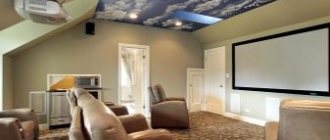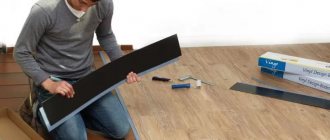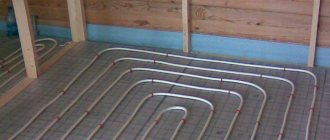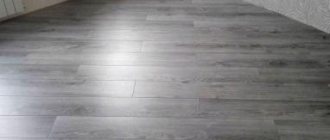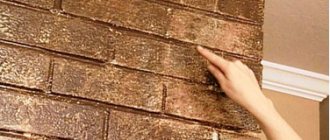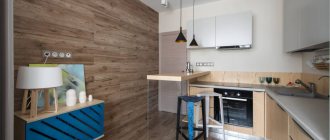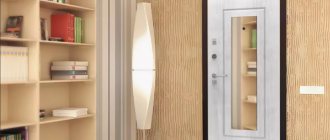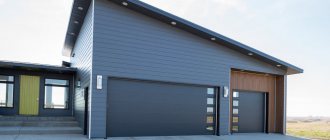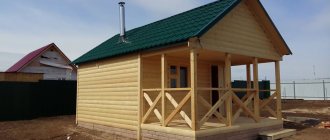Book a discount on repairs up to 10% for 15 days!
Enter your number and we will reserve a personal discount for you
To protect the floor from premature wear, create a unique design and cladding, veneer is often combined with other materials:
- Veneer with a thickness of no more than 0.5 mm, applied on top of the board with an adhesive composition.
- Veneer coated with floor varnish. According to reviews from owners, the advantage of this type of cladding is its long service life.
- Veneer with vinyl top. Protects against scratches and moisture getting inside the board, which guarantees the integrity of the floor for 10 years. The material is ideal for the kitchen, bathroom or winter garden.
- Veneer, which is made from valuable wood species and with a finishing layer of vinyl film, which makes the floor even more wear-resistant - you will agree that this is a significant plus.
Today, manufacturers offer coating options that, using the photo printing method, are made in a variety of designs. This can be a pattern in the form of stone, grass and other textures that look very natural and realistic. In Moscow, the price of their production turns out to be quite high, but, according to customer reviews, the finished design is worth it, and you can choose any design.
Cork flooring: pros and cons
Pros of cork flooring
On average, the service life of cork flooring ranges from 7 to 10 years, it all depends on its operating conditions and type. Adhesive flooring options are considered the most wear-resistant and durable. Another big advantage of cork is that rodents and insects are not interested in it.
In addition, the floor is hypoallergenic, does not absorb or accumulate dust and does not emit toxins. All of the listed beneficial properties are a huge plus and allow the material to be used by people suffering from allergies and diseases of the respiratory system.
At the same time, the floor, despite its strength, is soft and springy underfoot, which has a positive effect on the musculoskeletal system of both adults and children of all ages, as the load on the spine and limbs is reduced. Therefore, orthopedic doctors especially recommend walking on cork floors barefoot, sitting and even lying on it.
Recommended articles on this topic:
- Arrangement of a small apartment
- Stages of renovation in an apartment
- Turnkey cosmetic repairs
An additional advantage is good thermal conductivity, which is almost twice as high as that of air (0.04 versus 0.025 W/mK).
Manufacturers of cork floors also note the excellent soundproofing characteristics of oak bark material as a plus: the noise absorption coefficient can reach 0.85, that is, you will not bother your neighbors if you have a global rearrangement of furniture. But, of course, a cork floor will not protect you or your neighbors if noise comes from outside. But this circumstance can hardly be attributed to the disadvantages of coverage.
Thanks to the high coefficient of friction (0.4), the cork board does not slip at all - again a huge plus for families with small children. But it remains smooth due to protective wax or polymer coatings. The deformation of the cork material is no more than 0.2 mm (a huge plus) only in the presence of a static load (furniture, interior items), but once the weight is removed, the coating levels itself out.
Other beneficial properties of cork flooring are:
- resistance of the floor to ultraviolet radiation - the design retains its appearance, which, of course, is a big plus;
- the impossibility of spontaneous combustion is a huge plus for an environmentally friendly material;
- resistance to rotting and decomposition;
- lack of reaction to exposure to chemicals other than alkalis.
Cons of cork flooring
Of course, like any material, cork flooring also has its downsides.
The main disadvantage is the high price of the material, and in the future its operation may turn out to be expensive. Yes, cork is more expensive than traditional laminate, but it is more economical than solid wood. Of course, synthetic finishing layers are not natural materials, but they provide a guarantee of durability and strength. And as an investment for 10 years, purchasing such a coating looks more promising than a cheaper analogue, laminate, for example, whose service life is no more than 3–5 years.
The next disadvantage is the need for maintenance and additional treatment of the floor finish every 1-2 years to restore its properties and protect the natural board from absorbing odors, fats and moisture, reducing the risk of deformation and scratches on it.
Another disadvantage is the irrationality of installing a “warm floor” system under a cork covering due to its low thermal conductivity. Experts note not only the ineffectiveness of heat transfer when using materials together - no more than 20%, but also warn about the risks of prolonged heating of the cork coating, which can lead to drying out of the adhesive layer and delamination.
A minor drawback may be that the floor with locking systems gets wet, but this probability is small, since it only occurs as a result of improper installation. Next, we will consider the basic installation techniques, the observance of which guarantees that when using a cork floor you will not encounter some problems and disadvantages.
If you are already registered, enter your login information!
Previous article Next article
Cork flooring pros and cons
Content
- Which cork floor is worthy of attention?
- What characterizes cork floors?
- What is better - gluing or laying
- Video: a short master class on gluing cork floors
Cork coverings began to come into use among Russian owners of houses and apartments relatively recently, and therefore debates about their advantages and disadvantages still do not subside. The material is completely unusual, which most people previously had to deal with only at the level of bottle caps, fishing tackle or some parts of good shoes. Cork flooring, the pros and cons of which we will try to consider in this publication, is an absolutely unknown type of finishing coating for many.
Cork flooring pros and cons
Ignorance always breeds uncertainty. New products always cause certain concerns among the majority of ordinary consumers, and here everything comes with a fairly high price. Often, a person tormented by uncertainty takes a simpler approach - he refuses innovations and turns to the usual laminate, tile or linoleum. How can we help such a person make the right choice?
The article will be structured in such a way that theses about the structure of cork flooring and its qualities, positive or even negative, are supported by the opinion of ordinary people who have already experienced such a coating in everyday use. Reviews from unbiased readers will sometimes say much more than just the praising lines of advertising brochures.
Under no circumstances should you consider certain brands of cork floors or specific collections mentioned in the text as advertising material or, on the contrary, as some kind of anti-advertising statements. There are no such goals, it’s just that some characteristics of the sexes are better considered using specific examples, and possible shortcomings are most often due to the notorious “human factor”
Which cork floor is worthy of attention?
What is a cork, for starters. This is the bark of the cork oak, which is grown in climatic latitudes characterized by high humidity and heat.
Stripping the bark from a cork oak tree
The Mediterranean countries can boast of such climatic features. It is there that the most famous cork plantations and companies engaged in its processing and production of building materials based on it are located. Thus, Portugal and Spain are recognized leaders in this area.
Western Mediterranean - the best cork oak trees grow there
Cork oak is also grown in some countries on the North African Mediterranean coast. Raw materials from this region are supplied to other producers in continental Europe and even Russia.
Raw cork is being prepared for shipment to production
The ubiquitous Chinese have also mastered the cultivation of cork oak and the production of various building materials, including flooring. However, other climatic conditions of cultivation have an effect, and as experts note, cork of Asian origin differs from the traditional one in a slightly worse way.
Perhaps the most significant “giant” among all world manufacturers, enjoying unquestioned authority, is the Portuguese concern “Amorim”, whose products are known for the brands “Ipocork” and “Wicanders”. The Spanish and Bertrancork, the Portuguese Valerio, and a number of companies from Switzerland, Germany, and Holland, which exclusively use cork coming from the Iberian Peninsula, deserve every respect.
But when purchasing material, unknown brands should be treated with a certain degree of caution. Cork flooring cannot be considered affordable for everyone (this is one of its main drawbacks), and paying a considerable amount for a “pig in a poke” is probably not the most reasonable approach.
Let's listen to opinions.
This is the experience Semyon from Khimki near Moscow :
“I fell for the seller’s persuasion and the low price and bought a “Chinese”, which, in terms of its qualities, according to the advertisement, seems to be not inferior to the “classic”. Still inferior. I understood it in hindsight when I read about the technology of growing and processing raw materials. Unusual conditions for cork oaks make the material loose, and even with all the externally beautiful texture, the density is not at all the same. The manufacturer compensates for this by adding bulk organic binders – glue. Yes, you can achieve strength this way, but there is not a trace of the warmth, elasticity, and pleasantness characteristic of cork.”
But there is another opinion, which will say that cork produced in the Pyrenees is not an absolute guarantee of high quality and the required naturalness.
Anton S. from Kostroma testifies :
“All my ears were buzzing about Portugal. I bought it thanks to the advisors “Corksribas” - by the way, I liked both the price and the appearance. But then the problems started.
I did not receive any expected comfort in the room. On the contrary, it is a very rough, rough surface, which is especially noticeable when you walk barefoot. The hardness is such that a glass dropped to the floor shatters. Constant feeling that the floor surface requires cleaning. It would be nice to put it in the hallway, but no, I have a living room like that!”
What is the reason? It’s simply that the consumer did not pay attention to the purpose of a particular type of coating when purchasing, simply succumbing to the “charm” of the country of origin and the low price. But it was possible to clarify in advance that Corksribas products are among the most “budget” ones. The low density of the cork layer itself is balanced by ceramic varnish, and such a coating would indeed be appropriate in the kitchen or hallway, but not in the living room.
What characterizes cork floors?
Now, a little more about the expressed advantages of high-quality cork flooring, which distinguish them from other materials.
- First of all, this is the naturalness of the material, if, as already noted, it is not oversaturated with synthetic compounds. This coating has high environmental properties and is not capable of causing allergies even in people predisposed to it.
- Natural cork flooring combines strength with elasticity. The indicator of residual deformation is very small - after removing the load, the surface tends to return to its original state.
There are, of course, vulnerabilities in this regard. Thus, cork does not tolerate exposure to sharp objects or accentuated point loads.
Furniture legs need to be “shod” with pads
It will be necessary to install spacers under the legs of the furniture, and it is generally not recommended to walk on such a surface in stiletto heels.
You should not walk on cork floors in stiletto heels.
But for a person’s foot this is probably the most comfortable material, with very pleasant elasticity. This coating is especially good for children's feet.
Cork is an excellent covering for a nursery.
- The thermal insulation properties of cork are incomparable to any other natural material. Cork is warm to the touch even by itself, plus it becomes an excellent insulating layer that does not allow the cold from the concrete floor to pass through.
- Cork floors, thanks to the special structure of the material, perfectly absorb noise, significantly improving the overall sound insulation of the room and thereby increasing the comfort of living.
Cork is an excellent thermal and sound insulator
- A fundamental difference from other wood is that cork is not afraid of water and is not susceptible to rotting from exposure to moisture. This opens up the possibility of using cork flooring even in the bathroom - it is convenient in terms of comfort, warmth of the coating, and there is no risk of slipping on a wet floor.
Cork varieties vary in color and rich texture.
- An absolutely unique appearance that will probably not leave anyone indifferent. Different shades of cork and differences in texture allow you to create exclusive design compositions on the floor.
You can come across opinions about the ease of installation of cork covering as one of the advantages. You can argue with this. There are two different types of coatings, and while this characteristic is quite applicable to one, the situation is different with the other. More on this in the next section of the publication.
In the meantime, a few words about the shortcomings of the material. The high price has already been mentioned. It can be noted that cork is unstable to abrasive effects, especially when the top protective varnish layer wears out. It does not like such a coating of hard small debris on its surface - it can be carelessly pressed into the thickness of the material. You should not walk on such a floor in shoes with rubber soles - permanent marks may remain. In a word, its operation imposes a number of specific maintenance conditions on the owner.
What is better - gluing or laying?
So, you can find two types of cork flooring on sale.
1. If we talk about the ease of installation, then a kind of “cork laminate” wins in this matter. These are panels with a central HDF layer, which gives the coating the required rigidity. At the bottom there is a cork covering made of compressed crumbs (agglomerate). On top there may also be several layers of agglomerate and cork veneer, which gives the floor a decorative effect. The total thickness of such panels is about 12 mm.
Floating cork floor panels
Such panels are equipped with a locking system (like a “classic” laminate), and, indeed, installation of such a coating should not be particularly difficult if you have the initial skills and due diligence. After installation, the floor surface is covered with a special varnish, which is usually recommended or even produced by the manufacturers themselves.
Laying such a coating is not much different from installing a conventional laminate.
The only advantages of such a floor are the speed of installation and the possibility of dismantling, if necessary. Otherwise, it loses to its competitor, which will be discussed below. Thus, with large temperature differences, the joints of the panels may begin to separate. The fact is that the heterogeneity of the materials (cork itself and HDF) also gives an unequal coefficient of linear expansion.
2. Cork coverings laid with glue. This is where a lot of experience will be required to install the floor, since it is necessary not only to apply the adhesive composition correctly, but also to very carefully adjust the panels to each other, without leaving even the slightest gaps.
But such a coating is distinguished by its solidity, durability and, ultimately, complete naturalness. The panels used are two-layer. The bottom layer is compressed cork chips, and on top it is covered with solid high-grade veneer. The total thickness is in the range of 4 ÷ 6 mm, and this is quite enough for the cork to fully demonstrate its thermal and sound insulating qualities and become a comfortable covering.
Installing such a coating with glue requires good skills
Laying such a floor should be carried out on a carefully prepared base, without any differences, recesses or protrusions, or debris.
Here is a typical example described by Ivan Pavlovich from Novgorod:
“The unfortunate master who glued the cork for me left two small stones under the coating. At first it seemed like a trifle, but every time I stepped on this place with my bare foot, I remembered that “craftsman” with strong words. In the end, I got tired of it and had to call another specialist to cut out this area and carefully glue the “patch.” I had to fork out money because of its initial undemanding nature. Therefore, take my advice - ensure and ensure that before laying and gluing, the workers vacuum everything down to the smallest grain of sand!”
A separate advantage of adhesive cork floors is the ability to apply any mosaic patterns on the floor with cork of different colors, including curved ones. However, this is the lot of highly qualified craftsmen who have both the highest qualifications and the gift of an artist-designer.
You can lay out unique mosaic panels on the floor
So, let’s summarize which floors are better, according to the opinions of several consumers:
Alexey, Orel:
“I was convinced myself, and I advise everyone - the floor should be completely natural, so only an adhesive option! Just don’t take on the matter yourself, trust an experienced specialist with good recommendations. When I had a professional working for me, I tried to help him, and even tried to lay a few panels myself. The matter is complex, requiring an exceptional eye and well-developed coordination of movements. Even now, it seems, having understood how everything is done, I won’t take on the flooring in another room myself.”
Anna, Tver region:
“In two days, my husband and I easily covered the room with cork laminate, then covering it with two layers of varnish that was included in the kit. Everything seemed to be fine, but after the unrealistic heat in 10, the seams began to come apart, and the floor took on an unkempt appearance. It’s a pity that so much effort and money was spent, but it didn’t last long. The next run will be just glue!”
And, at the end of the publication, the opinion and advice of a professional who, over his many years of practice, has encountered literally all types of coatings and has laid tens of thousands of square meters of floors with his own hands:
Oleg Evgenievich, Moscow, builder-finisher with 30 years of experience:
“Firstly, either never fall for the “cheap” or demand the impossible. For example, if you take inexpensive linoleum, then no matter how carefully you lay it, it will not become better quality. Well, why should there be a different approach to traffic jams?
Secondly, you shouldn’t invent something in the hope of saving an extra penny. If the floor requires a specific water-soluble adhesive, then that is what you should use. Yes, you can take an organic one at a lower price, but the smell will torment you, it will take a very long time to dissipate, and the structure of the bottom layer of the cork will be clearly changed. The same can be said about varnish - it is the highest stupidity to buy an expensive coating, pay for its installation and then kill everything with low-quality varnish!
And third. Cork floors, those that are laid with glue, are the highest category of complexity of work, which not even any specialist will undertake. For such a floor to truly become durable and comfortable, three things are required: truly high-quality material, a qualified craftsman with relevant experience, and full compliance with all technological recommendations of the manufacturer for both installation and care of the coating during its operation. The cork floor will not forgive an amateurish approach!”
Video: a short master class on gluing cork floors
Previous article Next article
What is more effective: laying cork flooring or gluing it
In retail there are usually three types of cork floors:
- floating or interlocking floor;
- glue floor;
- technical jam.
The absolute leader in simplicity and convenience of self-installation is cork laminate, or interlocking flooring, which is panels with a central HDF layer that gives the floor the necessary rigidity. The bottom of the panel is a cork layer made of compressed chips (agglomerate), the top consists of several layers of agglomerate and decorative cork veneer. The total thickness of such panels is about 12 mm.
The panels are also equipped with a locking system (like a traditional laminate), and anyone who has basic skills in laying laminate with a locking system will appreciate this plus and can easily cope with installing this type of cork flooring. After installation, the surface must be coated with a special varnish, which can be purchased in the store along with the panels, or it comes as a bonus from the manufacturer when purchasing cork panels.
According to the owners, the advantage of this type of floor, in addition to quick installation, is its prompt dismantling. In other respects, which is noted as a minus, it is inferior to other types of floors, which we will consider further. First of all, this relates to the wear resistance of the joints, since with significant temperature changes they can diverge. This is due to the heterogeneity of the materials (cork itself and HDF) and the different ability of linear expansion, which must be taken into account when installing the panels.
When laying the floor, extreme care is required when applying the adhesive and careful adjustment of the cork panels to each other to eliminate gaps. Usually you can’t do this without the services of a professional, which can also be considered a disadvantage.
Cork panels consist of two layers: the bottom one is made of pressed chips, and the top one is solid with high-grade finishing veneer. The total thickness of the floor is 4 ÷ 6 mm, as a result of which the material fully reveals all its useful qualities (sound insulation, heat retention) and provides comfort and coziness in the house.
It should be remembered that such a floor is laid only on a well-prepared, leveled and clean base. An additional advantage of adhesive coatings is the ability to create patterns of any complexity on the floor: from simple mosaics from two or three types of cork in different shades to curvilinear patterns. Of course, to carry out a complex design solution, it is better to use the services of a highly qualified installer.
From the name “technical cork” it is clear that this type of coating is not used for finishing the board; production residues are used for its production. This material is used as a substrate when laying laminate flooring. Also, with the help of cork granules, you can eliminate defects and unevenness of the subfloor, for which the base is covered with crumbs.
Comparative characteristics of plug models
This section is dedicated to those who appreciate the benefits of cork flooring and are thinking about purchasing it. There are several coating options on the market, I’ll try to figure out what the advantages and disadvantages of each of them are.
Several types of cork cover allow you to diversify your decor
Choose the type of material based on your budget and needs
| Type of cork | Coating features |
| Adhesive tiles. | The design and installation method of this sample are somewhat similar to ceramic tiles. Despite the varied thickness of the tiles (3-7 mm), the most popular is the 6 mm one. The material is simply installed on the prepared coating using special glue. This prevents the slabs from diverging and the appearance of gaps between them. Thus, the adhesive method will allow for artistic installation, which will make the cork floor in the interior look quite original and fresh. |
Floating floor (interlock tiles). | The structure and method of laying this coating is similar to laminate. The model is multi-layered, equipped with a hard lining, onto which pressed cork is applied, and then natural veneer. The main advantage of interlocking tiles is that the panels are attached not to the floor, but to each other. This greatly simplifies the dismantling of the covering in case of moving. The instructions for installing such material are quite complex and require certain skills. But what is considered an advantage is, to some extent, also a disadvantage. The seams between the panels are not sealed, are susceptible to moisture and may collapse over time.
|
Rolled cork. | It is a homogeneous, seamless coating, whose installation is similar to the installation of linoleum. Before using a rolled cork, be sure to thoroughly prepare the surface, otherwise all roughness and irregularities will be visible. Also keep in mind that installation should go smoothly on the first try. The fact is that the glue dries quickly after applying the material to it, and you will no longer be able to trim or move the roll you are using. |
It's hard to believe, but this floor is also made of cork.
Installing interlocking tiles is similar to installing laminate flooring
This is what the roll coating looks like
Cork flooring in the kitchen and bathroom: pros and cons
Is it worth laying a cork board on the floor of the kitchen and bathroom, what are the pros and cons of the material in this case should be taken into account? Let's try to answer this question. Those who have used cork for kitchen floors are very pleased with the result, if the manufacturer's recommendations were followed during installation. Personal experience allows such people to find many advantages of such a solution. Although there is still an opinion that cork, like laminate and parquet, cannot be used in the kitchen and bathroom.
Undoubtedly, the kitchen and bathrooms are special areas in any apartment. Humidity, elevated temperature, and irregular ventilation have a bad effect on any finishing materials. But cork flooring is a very durable, fracture-resistant coating that does not slip (a big plus for a bathroom).
Consumers who decide to choose cork flooring for their kitchen note, of course, both the pros and cons of using it. Objective advantages are thermal conductivity - when walking on the floor barefoot, your feet do not freeze, spilled water is easily cleaned up and is not absorbed by the coating. The dishes do not break when dropped, since, despite the strength, the floor is quite soft.
Well, the disadvantages are as follows: it is difficult to notice dirt on the complex pattern of a cork floor, so it is better to wipe it entirely, then you will definitely not miss a single speck. According to reviews from the owners, when using a cork floor in the bathroom, no disadvantages were found, but on the contrary, enthusiastic owners cite only positive advantages and rejoice at the comfort.
Just keep in mind that for the floor in the kitchen or bathroom, a coating that is glued to the base is suitable. Then you will get the warmest and most consistent surface possible, and if installed correctly, you will not have to worry about mold or dirt. Compliance with installation technology will ensure thermal and waterproofing. In a bathroom, such a floor means comfort and uniqueness, the complete absence of fungus and the elimination of the risk of falling due to the non-slip surface, that is, nothing but advantages. It is recommended to entrust the installation of cork flooring to professionals, then you will be spared the hassle for many years.
How to properly care for cork floors
Caring for a cork floor is quite easy - another plus: you can clean it with a vacuum cleaner, wipe it with damp cloths using detergents that do not contain aggressive alkaline components. However, pay attention to spilled liquid; it is better to clean it up immediately. The cork is not afraid of water, but you shouldn’t get it too wet either.
It is not recommended to clean the floor with hard brushes, metal scrapers, or abrasives, as there is a risk of scratching the surface. If stubborn stains appear on the cork, you can easily remove them with fine-grained sandpaper. Of course, the coating will be damaged and a small defect will form on it, but this can be eliminated by applying wax or varnish to the damaged area.
As we said earlier, once every 1-2 years the floor with photo printing needs to be updated. Additional maintenance costs are a minus, but the big plus is that the floor will always look like new, and its durability will remain high. First, the old varnish is removed with sandpaper or a sanding machine, its remains are removed from the floor with a vacuum cleaner, and then fresh polyurethane varnish is applied to the cleaned surface, which dries within 12 hours. The coating completely restores the original appearance and continues to delight.
In order for the floor to last even longer and reveal all its advantages, you need to follow a few simple rules:
- Use stickers on the legs of heavy furniture or special pads made of cork or felt to protect the covering from dents.
- Place a rug to protect the floor in the hallway. Try to avoid rugs with a rubber or latex backing to prevent marks and streaks on the cork.
- Keep the temperature no higher than 20–25 degrees and humidity up to 50% in the room to reduce the risk of the cork floor drying out. In winter, it is advisable to use air humidification systems - this way you will prevent premature cracking of the coating and avoid other disadvantages of operation.
Rules for choosing cork flooring
To ensure that purchasing and installing cork flooring brings only pleasure, you need to know the basic rules for choosing the flooring in question. Experts recommend paying attention to the following criteria :
- Manufacturer. It is believed that the best/reliable manufacturer of the flooring in question is Spain, namely the companies Corkstyle, Wicanders, Cork.
- Appearance of the panels. The material must be carefully packed, the edges of each tile must not have “burrs” or unevenness, and the tiles must be the same size among themselves (to do this, simply attach one cork tile to another).
- Foreign impurities. You need to turn the tile over and inspect the underside of the cork floor - if foreign inclusions are found there that do not fit into the overall appearance, this means that the manufacturer decided to save money and added sawdust to the cork. The quality of such floors will be worse - the heat/sound insulation does not correspond to the declared characteristics, and the service life of such floors will be short.
- Presence of chamfer. If you plan to lay the cork floor yourself, then the presence of a chamfer will be an excellent addition - with its help you can hide errors in the work.
- Class of cork slabs. Class 31 is used to furnish a room with low traffic levels - for example, a children's room or bedroom. Class 32 cork flooring implies the use of the material in rooms with average traffic - for example, a kitchen or living room. And class 33 will indicate particularly high strength of the material - the cork can be laid in the hallway.
Cork floors are a new, high-quality and stylish material for arranging a comfortable room. Despite the fairly high cost of such flooring, it deserves the attention of consumers - safety, comfort, and ease of maintenance often become decisive factors when choosing.
( 66 votes, average: 4.94 out of 5)
Decorative plywood - characteristics and advantages of use
How to choose plastic windows: expert advice
Related Posts
How much does cork flooring cost?
When choosing a floor covering, everyone first of all pays attention to the price; it can become both a minus and a plus when the buyer makes a decision. The cost of a cork floor depends on its type, quality, density, manufacturer and is usually significantly higher than traditional analogues (and this is the main disadvantage). The cost of material for installing a floating cork floor ranges from 700 to 2,000 rubles per m2. Adhesive cork floors are more affordable - from 600 to 1,200 rubles per m2, which can be a plus for choosing this flooring material option.
Prices for laying floors also vary depending on its type, complexity of the work and qualifications of the technician. Installation of interlocking cork covering costs from 250 to 350 rubles per m2. Laying an adhesive cork floor costs more - from 350 to 500 rubles per m2 - an obvious disadvantage. Installing slabs diagonally will cost even more, which, of course, is also a minus.
Cooperating with is reliable and prestigious. The specialists working here are professionals of the highest level. operates throughout Moscow and the Moscow region.
Types of cork floors
The design of the floor covering in question is a multi-layer “pie”:
- crushed cork (cork agglomerate);
- resin-based wood dust (solid board);
- another layer of cork agglomerate;
- face covering.
It is worth noting that this technology for the production of cork flooring is strictly observed by all manufacturers; there may be variations only in the front layer. The surface of a cork floor can be made of decorative wood veneer or valuable wood species, but in this case it is covered with varnish or vinyl. It is worth clarifying that even vinyl coverings do not reduce the resistance of the material to damage - such floors are laid in those rooms where there is a lot of traffic/crowding of people.
Manufacturers present two types of cork flooring on the market - adhesive and floating.
Floating cork floors
They are panels with a thickness of 9-12 mm, which are joined together using special grooves. The service life is 5 years, but this indicator depends on two factors :
- the varnish used for the front covering - if the manufacturer uses high-quality finishing material in the work, then the service life of such a floor covering increases;
- operating conditions - with a low load on floating cork floors they can be used for 10 years, with a high load - no more than 5 years.
Please note: experts do not recommend installing this type of cork flooring in rooms with high humidity levels - there is a high probability of the slabs swelling.
Adhesive cork floors
They are tiles with a thickness of 3.2 – 4 – 6 mm, which are laid by gluing to the base. The most durable type of adhesive cork flooring is tiles with a thickness of 3.5 mm, which are actively used in the arrangement of industrial and public premises with high traffic volumes.
Adhesive cork flooring is quite difficult to install (there are some nuances/features), but its service life is 7 years even with the highest/aggressive impact.
Please note: experts recommend choosing 6 mm thick adhesive cork floor tiles for apartments and residential buildings - this is what will retain heat in the room and provide the required/manufacturer-declared level of comfort.
